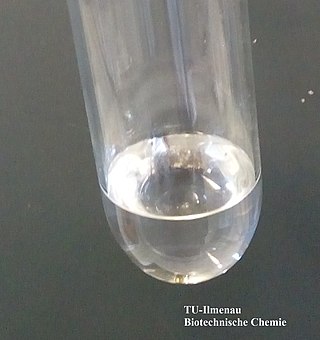Related Research Articles

Lithium hydroxide is an inorganic compound with the formula LiOH. It can exist as anhydrous or hydrated, and both forms are white hygroscopic solids. They are soluble in water and slightly soluble in ethanol. Both are available commercially. While classified as a strong base, lithium hydroxide is the weakest known alkali metal hydroxide.
Elastic properties describe the reversible deformation of a material to an applied stress. They are a subset of the material properties that provide a quantitative description of the characteristics of a material, like its strength.

2,2,6,6-Tetramethylpiperidine, abbreviated TMP, HTMP, or TMPH, is an organic compound of the amine class. In appearance, it is a colorless liquid and has a "fishy", amine-like odor. This amine is used in chemistry as a hindered base. Although TMP finds limited use per se, its derivatives are a mainstay of hindered amine light stabilizers.
The speed of sound in any chemical element in the fluid phase has one temperature-dependent value. In the solid phase, different types of sound wave may be propagated, each with its own speed: among these types of wave are longitudinal, transversal, and extensional.

Germanium tetrachloride is a colourless, fuming liquid with a peculiar, acidic odour. It is used as an intermediate in the production of purified germanium metal. In recent years, GeCl4 usage has increased substantially due to its use as a reagent for fiber optic production.

Butyraldehyde, also known as butanal, is an organic compound with the formula CH3(CH2)2CHO. This compound is the aldehyde derivative of butane. It is a colorless flammable liquid with an unpleasant smell. It is miscible with most organic solvents.
This page provides supplementary chemical data on barium chloride.
This page provides supplementary chemical data on sodium chloride.
This page provides supplementary chemical data on chloroform.
This page provides supplementary chemical data on 1-Hexene.

2,4,6-Trichlorophenol, also known as TCP, phenaclor, Dowicide 2S, Dowcide 2S, omal, is a chlorinated phenol that has been used as a fungicide, herbicide, insecticide, antiseptic, defoliant, and glue preservative. It is a clear to yellowish crystalline solid with a strong, phenolic odor. It decomposes on heating to produce toxic and corrosive fumes including hydrogen chloride and chlorine.
This page provides supplementary data about the noble gases, which were excluded from the main article to conserve space and preserve focus. Oganesson mostly not included due to the amount of research known about it.

Tetramethylethylene is a hydrocarbon with the formula Me2C=CMe2 (Me = methyl). A colorless liquid, it is the simplest tetrasubstituted alkene.

Gadolinium diiodide is an inorganic compound, with the chemical formula of GdI2. It is an electride, with the ionic formula of Gd3+(I−)2e−, and therefore not a true gadolinium(II) compound. It is ferromagnetic at 276 K with a saturation magnetization of 7.3 B; it exhibits a large negative magnetoresistance (~70%) at 7 T near room temperature. It can be obtained by reacting gadolinium and gadolinium(III) iodide at a high temperature:
References
- ↑ CRC handbook of chemistry and physics : a ready-reference book of chemical and physical data . Lide, David R. (84th ed.). Boca Raton, Fla.: CRC Press. 2003. pp. 4–131. ISBN 0849304849. OCLC 52548731.
{{cite book}}: CS1 maint: others (link) - 1 2 CRC handbook of chemistry and physics : a ready-reference book of chemical and physical data . Lide, David R. (84th ed.). Boca Raton, Fla.: CRC Press. 2003. pp. 4–49. ISBN 0849304849. OCLC 52548731.
{{cite book}}: CS1 maint: others (link) - ↑ "MSDS - C7887". www.sigmaaldrich.com. Retrieved 2019-11-18.
- 1 2 3 CRC handbook of chemistry and physics : a ready-reference book of chemical and physical data . Lide, David R. (84th ed.). Boca Raton, Fla.: CRC Press. 2003. pp. 5–10. ISBN 0849304849. OCLC 52548731.
{{cite book}}: CS1 maint: others (link)
- Except where noted otherwise, data relate to Standard temperature and pressure.
- Reliability of data general note.